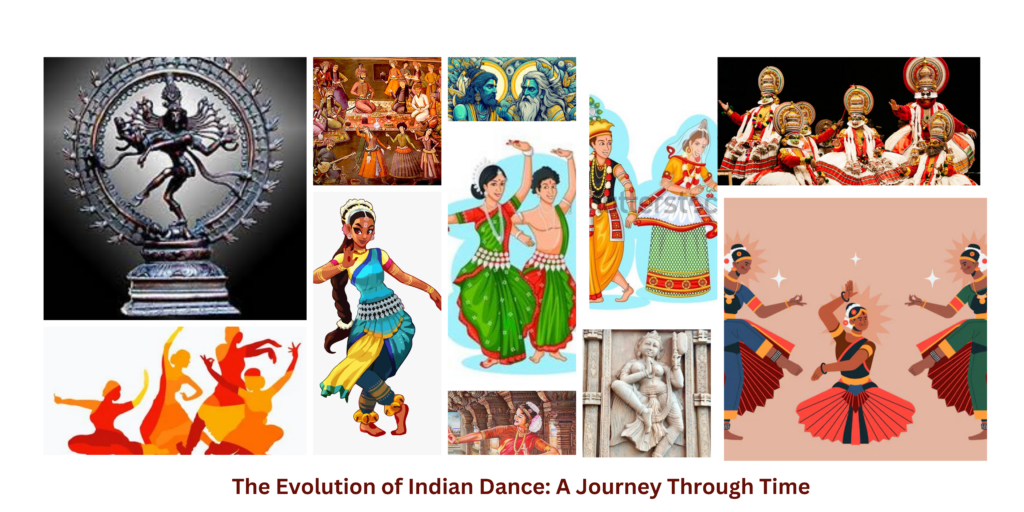The Evolution of Anient Indian Dance: A Journey Through Time
India is a diverse and cultural country where dance, music, architecture, and art from ancient times intertwine to create a rich tapestry of heritage and tradition. The history of Indian dance forms is a fascinating journey through centuries, reflecting the country’s spiritual, social, and artistic evolution.
In the Vedic period, Indian dances primarily served ritualistic purposes and were deeply intertwined with religious and spiritual practices. People performed these dances as ritualistic expressions with strong connections to religious and spiritual practices. They performed the dances as part of ceremonies, often intending to invoke divine blessings or narrate mythological stories. Scholars have inferred various key aspects of dance from Vedic texts and related literature.
The classical period of Indian dance, spanning from the 2nd century BCE to the Middle Ages, was a period of significant development and codification of dance forms. Bharata Muni composed the Natyashastra, laying the foundations of India’s classical dance tradition.
1. Dance in the Vedic Period
The origins of Indian dance trace back to the Vedic period (c. 1500 – 500 BCE), where people deeply associated it with religious rituals and spiritual practices.The Samaveda, emphasize the importance of music and dance in rituals designed to invoke divine blessings. Throughout yajnas (sacrificial ceremonies), people performed dances to please the gods and ensure the prosperity of the community.
Dancers, male and female, held significant roles in these ceremonies. Devadasis, or temple dancers, were among the earliest professional dancers, dedicated to performing in temples as a devotional act. Dance movements were symbolic, telling stories of creation, preservation and cosmic events.
Key Aspects of Dance In the Vedic Period
Ritual and Religious Significance: In yajnas (sacrificial rituals) and other religious ceremonies, dancers performed dances to please the gods and ensure the success of the ritual.
Accompaniment with Music: The Samveda, consisting of sung hymns, indicates that musicians accompanied dancers, intertwining music and dance. They utilized the veena (a stringed instrument) and various types of drums.
Performers: Men and women took part in dance. Temples specially trained Devdasis, who emerged as an important class of artists dedicated to this sacred art form.
Symbolism and Storytelling: Dancers depicted mythology and Vedic scriptures through their movements and gestures. The themes of the dance often include cosmic dances of creation, preservation, and destruction.
2. The Classical Era
In the classical era, various dance forms were developed and codified, and many of these continue to be celebrated and practiced today.This period was marked by Bharata Muni’s composition of the Natya Shastra, a comprehensive treatise on performing arts that laid the foundation for classical Indian dance.
Key Aspects of Dance In the Classical Period
Natya Shastra: This ancient treatise, attributed to the sage Bharata Muni, is considered the most comprehensive and authoritative text on Indian dance, drama, and music. It provides detailed guidelines on dance techniques, gestures (mudras), expressions (rasas), and postures (karanas). The Natya Shastra laid the groundwork for all classical Indian dance forms.![]()
- Abhinaya: The art of expression in dance, abhinaya is classified into four types by the Natya Shastra
- Angika: Physical expressions using body movements.
- Vachika: Verbal expressions using dialogue and song.
- Aharya: External expressions using costumes, makeup, and jewelry.
- Sattvika: Internal expressions conveying mental and emotional states
Patronage and performance context
- Temple Patronage: Dance became an integral part of temple rituals and worship. Devadasis or temple dancers performed dances intended to embody spiritual devotion and religious narratives as offerings to the gods.
- Royal Patronage: Kings and nobles patronized the art of dance and patronized the court through dance. Court dancers known as Rajnartaki performed at the royal court, contributing to the refinement and sophistication of the dance style.
Development of Regional Styles
- Bharatanatyam: Originating in Tamil Nadu, Bharatanatyam evolved from the temple dances of Devadasis. It is characterized by intricate footwork, expressive hand gestures (mudras), and storytelling through dance.
- Kathak: This North Indian dance form combines expressive gestures and swift footwork. The dance originated from the temples and courts of North India. It has been influenced by Persia in the Mughal Empire. It has incorporated diverse elements into its expressive repertoire.
- Odissi: Hailing from Odisha, Odissi is one of the oldest classical dance forms. It features fluid movements and intricate poses, often depicting stories from Hindu epics and mythology.
- Kathakali: Originating in Kerala, Kathakali is a dramatic dance form known for its elaborate costumes and makeup. It combines dance, music, and acting to narrate stories from epics like the Ramayana and Mahabharata.
- Manipuri: From the northeastern state of Manipur, this dance form derives its roots from the region’s folk traditions and Vaishnavism. Known for its graceful movements and devotional themes, it is celebrated for its cultural richness.
Spiritual and Narrative Themes
- Mythological Narratives: Classical dances often depict stories from Hindu epics such as the Ramayana and Mahabharata, Puranas and folklore, and bring them to life through movement and gesture.
- Devotional Themes: People viewed dance as a means of worship and spiritual expression.. Many performances centered around bhakti (devotion) to deities, conveying themes of love, devotion, and divine play.
Technique and Training
- Guru-Shishya Parampara: The traditional system of mentorship, where the guru (teacher) passed knowledge and skills to the shishya (disciple), was central to the training of dancers.. This ensured the preservation and continuity of dance traditions.
- Rigorous Training: Classical dancers underwent rigorous training in technique, rhythm, and expression. Mastery of various aspects of dance, including footwork, gestures, and facial expressions, was essential.
Costume and Makeup
- Elaborate Costumes: Designers crafted costumes to enhance the visual appeal and thematic representation of the dance. They varied according to the region and style, often incorporating rich fabrics, jewelry, and accessories.
- Symbolic Makeup: Makeup played a crucial role in conveying characters and emotions. In forms like Kathakali, makeup was highly elaborate and symbolic, helping to define different roles and moods.
The classical era of Indian dance was a period of immense creativity and refinement. The development of distinct regional styles, the codification of dance techniques, and the patronage from temples and courts all contributed to the rich tapestry of Indian classical dance.People have preserved and passed down these traditions through generations, continuing to captivate audiences with their beauty, grace, and profound storytelling.

